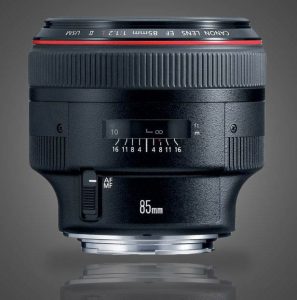Best Portrait Lenses for Canon
Before I continue, let me stress that there are as many different portrait lenses as there are styles of portraiture. Some photographers manage to take unique portraits with wide angle lenses or super-telephotos, toy plastic lenses, and even pinhole cameras, so the following list should not be considered exhaustive by any means.
Traditionally, though, portrait photographers have used lenses that offer the following characteristics:
- large maximum aperture for shallow depth of field (blurred background) and low-light shooting, with higher numbers of aperture blades or rounded blades for smooth bokeh
- low distortion, slightly compressed perspective
- sharp and very high resolution
For 35mm cameras, these characteristics are usually found in prime lenses in the range of roughly 80 to 150mm, but that range frequently extends to 200mm on the long end as well. Some of the most renown portrait lenses have been 85mm, 105mm, and 135mm.

Canon EF 85mm f/1.8 and f/1.2 L II
Both excellent lenses optically, and in the heart of the traditional portrait range whether you’re using an APS-C or full frame camera. The f/1.2 model is a little softer around the borders wide open, but it does provide twice as much light (ie, one f-stop) as the f/1.8. Keep in mind that at f/1.2, the depth of field is extremely narrow, so keeping all of the features of a subject’s face in focus can be difficult. I highly recommend the 85mm f1.8 as a first portrait lens; it has outstanding optical quality, great bokeh, excellent low-light performance, and is relatively inexpensive.
Sigma 85mm f/1.4 ART and 135mm f/1.8 ART
Sigma’s ART series lenses are amazingly sharp, and these are two in particular are among the sharpest lenses ever made by any manufacturer. Some people have complained about focusing problems with Sigma lenses, but I find them to be reliable and fast, and they produce gorgeous image quality. Sigma lens designs tend to be heavier than Canon, and they often produce pincushion distortion rather than barrel (as Canon does), so images may look flatter if you don’t use lens correction. If you can carry the weight and have the cash, buy these lenses.
Sigma 85mm f.1.4 ART costs [amazon template=price&asin=B01M0UO0HX] and the Sigma 135mm f/1.8 ART costs $1399
Canon EF-S 60mm f2.8 Macro

If you’re using a cropped sensor camera like the 7D, 60D, or Rebel series, the 60mm f2.8 macro ($445) lens offers a perspective much like a 100mm lens on a full frame camera. It is incredibly sharp, offers a nice wide maximum aperture at f2.8, and has the added benefit of being a true 1:1 macro lens… probably the best macro lens made for APS-C cameras. Although this lens doesn’t offer maximum apertures as wide as an f/1.8 lens, and therefore, it doesn’t blur the background as well, it does give you the option for shooting extreme close ups of eyes, lips, etc., not to mention non-human subjects if you want to photograph insects or watch faces or other still objects.
Canon EF 135mm f/2L USM
The Canon EF 135mm f/2L USM is another extremely sharp lens (often referred to as the sharpest Canon lens made), with the maximum aperture extended to f2 for shallower depth of field. For an “L” series lens of such high quality, it’s also relatively inexpensive, at just over $1000. Like all wide lenses, it’s also great for sports and low light work; this lens offers a very distinctive image quality… I highly recommend it. Great for photographers who would like to extend their working distance a little, or get tighter shots. The 200mm f2 is even more desirable for the same reasons, but it’s price tag makes it prohibitively expensive for most of us.
Canon EF 70-200mm f2.8L IS USM II
One of the few zoom lenses that offers high enough optical quality to really be just as good as a prime lens, the 70-200 f2.8L IS II is not cheap at around $2200, but it’s such a versatile, high quality lens that it’s hard for a professional to live without. For those of you who are not shooting in the studio and are doing environmental portraiture, journalism, location commercial shoots, etc, a lens like this will make your life much easier. In many location shoots, a photographer simply doesn’t have the space to move further away from a subject to re-frame a shot… a zoom lens like this one can be a life saver. Though f2.8 is not especially wide in comparison to other portrait lenses, it is certainly wide enough to offer nice smooth bokeh, especially at 200mm.
Canon 50mm f1.4
For APS-C, a 50mm falls into the lower range of focal lengths that are typically considered “portrait” lenses. I generally prefer a slightly longer telephoto for the job, but many people take great shots with a 50mm. The f1.8 version is also quite good optically and very inexpensive at about $120, but the f1.4 offers slightly better bokeh because of its aperture design, and of course, a bit more light. On the other hand, it costs roughly just under $400.



